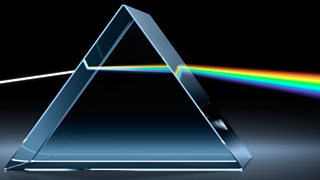When Yellow Light Hits A Yellow Animal, Is The Light Reflected Or Absorbed?
Low-cal waves
Light travels as transverse waves and faster than audio. It tin be reflected, refracted and dispersed. Ray diagrams show what happens to light in mirrors and lenses. Eyes and cameras notice low-cal.
Color
White light is a mixture of many different colours, each with a different frequency . White light can exist divide up into a spectrum of these colours using a prism, a triangular block of glass or Perspex.
Light is refracted when information technology enters the prism, and each colour is refracted by a different corporeality. This means that the light leaving the prism is spread out into its different colours, a procedure called dispersion .

The spectrum
Hither are the vii colours of the spectrum listed in guild of their frequency, from the lowest frequency (fewest waves per 2nd) to the highest frequency (most waves per 2nd):
- red
- orange
- xanthous
- greenish
- blue
- indigo
- violet
This mnemonic is one fashion to think the order: 'Richard Of York Gave Battle In Vain'.
Coloured light
There are iii primary colours in low-cal: cherry-red, green and bluish. Lite in these colours can be added together to brand the secondary colours magenta, cyan and xanthous. All three master colours add together make white light.
The way coloured light mixes is very different from the style that pigment does.
When calorie-free hits a surface, some of it is absorbed and some of it is reflected. The low-cal that is reflected is the colour of the object in that light. For example, a bluish object absorbs all the colours of the spectrum except blue: it reflects blue calorie-free.
The tabular array gives some more examples, displaying the color of light shining on an object, the colour(south) captivated by an object, the colour reflected by an object in this low-cal and the colour of an object seen in this light.
| White paper | Red apple | Green apple | |
|---|---|---|---|
| Colours(s) that the object tin can reflect | All | Red simply | Light-green merely |
| Appearance of object in white low-cal | White (no colours absorbed) | Cerise (all colours absorbed except red) | Green (all colours absorbed except green) |
| Appearance of object in red light | Red (simply cherry-red light to reverberate) | Red | Black (no green light to reflect) |
| Appearance of object in green light | Greenish (just green light to reflect) | Black (no ruby light to reflect) | Greenish |
| Appearance of object in blue light | Blue (only blue lite to reverberate) | Black (no red light to reflect) | Blackness (no green low-cal to reflect) |
Objects appear blackness in white low-cal because they absorb all colours and reflect none. Objects also appear black in any single color of light if their colour is non the same as the light. For case, a green object appears blackness in any other light than green (or white which contains green) because in that location is no dark-green light shining on it to reflect into your eyes.
Source: https://www.bbc.co.uk/bitesize/guides/zq7thyc/revision/6
Posted by: irvinhaster.blogspot.com

0 Response to "When Yellow Light Hits A Yellow Animal, Is The Light Reflected Or Absorbed?"
Post a Comment